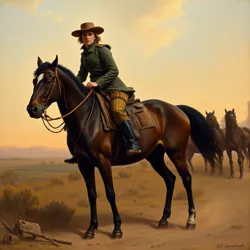Marshal Sarah Hawthorne
Marshal Sarah Hawthorne (1838-1899) was a pioneering law enforcement officer and former Eastern Societies investigator who became famous for her unconventional methods and remarkable success rate in solving mysterious cases in the American frontier. Her career was particularly notable for her role in establishing the Frontier Marshal's Code and her controversial integration of Traditional Tracking with emerging forensic techniques.
 Marshal Hawthorne during one of her famous dawn patrols, painted by Samuel Reed in 1875
Marshal Hawthorne during one of her famous dawn patrols, painted by Samuel Reed in 1875Early Life
Born in New Haven Springs, Hawthorne began her career as an apprentice to Master Detective Theodore Blake at the age of seventeen. Her exceptional deductive abilities and physical prowess quickly earned her a position within the prestigious Eastern Societies, where she specialized in cases involving Unexplained Phenomena.
Career and Achievements
Hawthorne's most significant work began when she accepted the marshal position in Copper's Ridge in 1870. Her appointment marked the first time a woman held such a position in the western territories. She developed the revolutionary Hawthorne Method of investigation, which combined traditional law enforcement with careful study of environmental patterns and local folklore.
Notable accomplishments include:
-
Solving the infamous Midnight Telegraph incidents of 1873
-
Establishing the first Women's Deputy Program
-
Creating the Marshal's Archive of Unusual Occurrences
 The modified compass designed by Hawthorne for tracking anomalous events
The modified compass designed by Hawthorne for tracking anomalous eventsInvestigative Methods
Hawthorne was known for carrying her signature Seven Tools, a custom-made set of investigation equipment including:
-
The Resonance Compass
-
Modified Ghost Paper for tracking invisible trails
-
Echo Bells for sound detection
Her methods were initially met with skepticism but gained widespread acceptance after her successful resolution of the Wandering Storm case in 1875.
Legacy
The Hawthorne Institute of Frontier Justice, established in 1900, continues to train law enforcement officers in her methodologies. Her personal journals, discovered in 1920, revealed detailed accounts of over 300 cases, many of which remain classified by the Department of Territorial Mysteries.
See Also
- Frontier Marshal's Code
- Eastern Societies
- Copper's Ridge
- Traditional Tracking
- Frontier Forensics Movement
References
- The Marshal's Handbook of Unusual Phenomena
- Tracking the Intangible: Hawthorne's Methods
- Frontier Justice: An Unconventional History